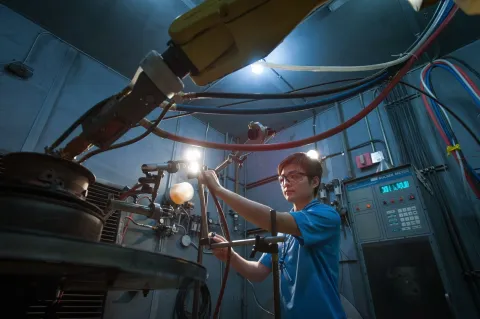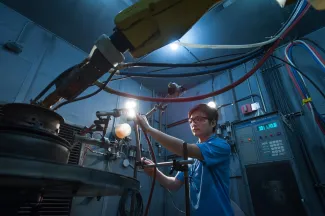"Materials engineers are interested in the entire life cycle of a material – from extracting raw materials (like metals), processing the material so it can be used, using the material in various applications and finding ways to recycle or safely dispose of the material at its end of life."

- Program:
Materials engineers make a material impact in our world, shaping the future of performance and innovation across every aspect of our daily lives.
They are working at the forefront of sustainability, finding new ways to process, use and transform raw materials – and create revolutionary new materials – into applications ranging from aerospace to health care.
Each material’s unique mechanical, thermal, chemical and electrical properties affect how it performs and behaves in different conditions and determines it suitability for various applications. Materials engineers improve on existing materials and develop new ones to optimize their performance and sustainability.

What is materials engineering and what do materials engineers do?
“Our ability to manufacture certain products or do certain things is largely limited by materials and their properties,” says Dr. Chad Sinclair, a professor in materials engineering.
Copper, for example, is an excellent conductor of electricity, making it much in demand in energy applications. The high strength-to-weight ratio of carbon fibre makes it an ideal material for use in airplanes, spacecraft and engine parts. Plastics are easy to manufacture and offer incredible lightweight durability, yet they are made from non-renewable resource and can be difficult to recycle.
Read more about Dr. Chad Sinclair
Materials engineers are interested in the entire life cycle of a material – from extracting raw materials (like metals), processing the material so it can be used, using the material in various applications and finding ways to recycle or safely dispose of the material at its end of life.

“Materials engineers work in a very broad range of domains,” says Dr. Sinclair. “Traditionally, they have held positions in the mining and extractive material industries. In fact, when our department started more than 100 years ago, we were the department of metallurgy, which speaks to that connection to the mining industry.”
Materials engineers also work in the manufacturing realm, where they often focus on quality assurance or product reliability.
“This could be working with design teams to select the right material,” explains Dr. Sinclair. “If you choose the wrong material at the outset, you are going to end up with suboptimal performance or potential problems down the road. Materials engineers understand how different materials fit together and can work with a mechanical or manufacturing engineer to come up with workable solutions.”
Choosing the right material for a product is one of the most effective ways to achieve better performance, and can also contribute to reduced environmental impact in the manufacturing process and make it easier to reuse that material at the end of its life.
Materials engineers are also interested in how materials fail over time. They need to know the anticipated lifespan of a material, how it degrades, when it fails, and when it needs to be replaced or taken out of service. The stakes can be very high and even a matter of life or death if you think of the impact of a failed material in a nuclear reactor, hydrogen storage tank or aircraft component.

What’s it like to study materials engineering at UBC?
Your courses will give you a strong understanding of the entire materials life-cycle, including extracting raw materials, designing and engineering materials into products, understanding how materials perform and evaluating their performance, and finding sustainable ways to dispose of materials at their end of life.
Upper-year technical electives enable you to specialize in one of three streams – manufacturing and performance, minerals and metals extraction, or biomaterials engineering.
Many courses incorporate project-based learning, enabling you to get hands-on experience working with materials.

“For example, I teach a second-year course on material selection and design where students choose an object and then need to select the best material for that object, be it a pair of skis or a tank for storing hydrogen at high pressure,” says Dr. Sinclair.
He also notes that students at UBC are able to access state-of-the-art equipment, including an electron microscopy and x-ray diffraction facility where students can dive deeper into materials at a molecular level to learn how they behave in different conditions.
Finally, as one of the smaller engineering programs, there are lots of opportunities to get to know your classmates and your professors, and it’s a very welcoming and collaborative environment.
















